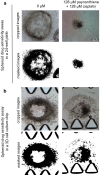Rapid spheroid assays in a 3-dimensional cell culture chip
- PMID: 34389056
- PMCID: PMC8361632
- DOI: 10.1186/s13104-021-05727-0
Rapid spheroid assays in a 3-dimensional cell culture chip
Abstract
Objective: The spheroid model provides a physiological platform to study cancer cell biology and drug sensitivity. Usage of bovine collagen I for spheroid assays is costly especially when experiments are conducted in 24-well plates, as high volume of bovine collagen I is needed. The aim of the study was to downsize spheroid assays to a microfluidic 3D cell culture chip and compare the growth, invasion and response to drug/compound of spheroids embedded in the 3D chip to spheroids embedded in 24-well plates.
Results: Spheroids generated from nasopharyngeal carcinoma cell line HK-1 continuously grew and invaded into collagen matrix in a 24-well plate. Similar observations were noticed with spheroids embedded in the 3D chip. Large spheroids in both 24-well plate and the 3D chip disintegrated and invaded into the collagen matrix. Preliminary drug sensitivity assays showed that the growth and invasion of spheroids were inhibited when spheroids were treated with combination of cisplatin and paynantheine at high concentrations, in a 24-well plate. Comparable findings were obtained when spheroids were treated with the same drug combination in the 3D chip. Moving forward, spheroid assays could be performed in the 3D chip in a more high-throughput manner with minimal time and cost.
Keywords: 3D cell culture chip; Bovine collagen I; Cisplatin; Mitragyna alkaloid; Nasopharyngeal carcinoma; Paynantheine; Spheroids.
© 2021. The Author(s).
Conflict of interest statement
The authors declare that they have no conflict of interests.
Figures



References
MeSH terms
Substances
Grants and funding
LinkOut - more resources
Full Text Sources
Miscellaneous

